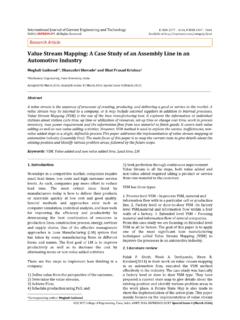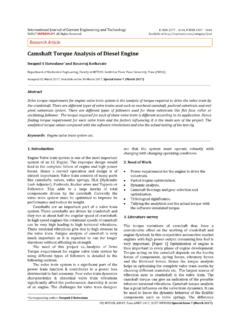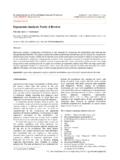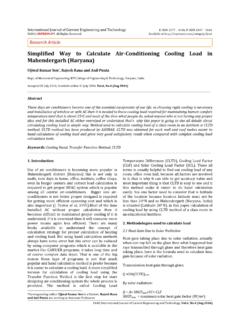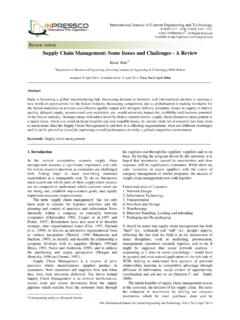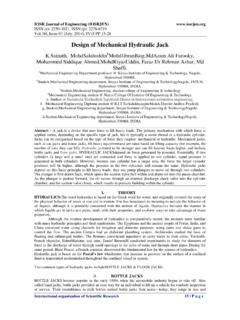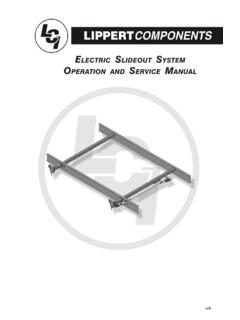Transcription of Design and Construction of Hydraulic Scissor Lift
1 International Journal of Current Engineering and Technology E-ISSN 2277 4106, P-ISSN 2347 5161 2017 INPRESSCO , All Rights Reserved Available at Research Article 92| MITCOE, & DIAT, Pune, AMET-2017, IJCET INPRESSO Special Issue-7 (March 2017) Design and Construction of Hydraulic Scissor Lift Sandeep G. Thorat *, Abhijeet R. Chiddarwar and Suva Prasana Prusty Department of Mechanical Engineering, Savitribai Phule Pune University, MIT College of Engineering, Pune Accepted 12 March 2017, Available online 16 March 2017, Special Issue-7 (March 2017) Abstract The following paper describes the Design and Construction of the Hydraulic Scissor lift. A Hydraulic Scissor lift is a mechanical device used for lifting of the loads to a height or level. The main objective of the use of Scissor lift is to reach to a desired height or level. A Scissor lift provides most economic, dependable and versatile methods of lifting loads as it has few moving parts which may only require lubrication.
2 Scissor lift is used in various combination as Hydraulic , pneumatic and mechanical. It is used because of its ergonomics as compared to other heavy lifting devices available in the market. As per the problem discussed in the paper the Design presented in the same is targeted to solve the problem faced by the industry. Keywords: Hydraulic Scissor Lift, Hydraulic Cylinder, Scissor Arm, Top Platform. Base Support Frame 1. Introduction 1 A Scissor lift is a vertical lifting device that consists of a platform. The mechanism incorporated to achieve this function is the use of linked, folding supports in a criss-cross pattern, known as a pantograph. pressure is applied to the outside of the lowest set of supports in order to create the vertical motion, due to this pressure the criss-cross pattern elongates to propel the work platform vertically upwards, the platform can be assisted with an extending 'bridge', this bridge helps in closer access in the work area thus eliminating inherent limits of only vertical motion.
3 The Scissor lifts can be classified according to energy used as Hydraulic , pneumatic or mechanical. each of these mechanisms has its pros and cons, which are studied and modified according to its application in various industries. Scissor lift Design is preferred over other heavy lifting devices available in the market because of its ergonomics. The frame is very sturdy & strong enough with an increase in structural integrity. Types of Scissor lifts are as follows 1. Hydraulic Lifts The Hydraulic scissors lift is operate using the fluid pressure that raises the platform via power through the use of pressurized Hydraulic oil. Slight speed variation is possible owing to temperature fluctuations that can alter the viscosity of the Hydraulic oil. *Corresponding author: Sandeep G. Thorat 2. Pneumatic Lifts The pneumatic lifts are operated using air pressure and they are very efficient because the power supply is carried out by compressing the atmospheric air.
4 Most of the units don t require electricity and thus can be used at any place where the air is available. 3. Mechanical Lifts The mechanical lifts are extended through a rack and pinion system or power screw , both of which can convert rotational motion. All the electric lifts are mechanical. The benefit of mechanical lift is that the teeth of its gear system prevent from slippage essentially. 2. Problem Statement This paper aims to provide the solution to the problem found in stacking the raw materials(cylindrical steel bars) as per the specification, that is to ton/bar, diameter ranging from 25mm to 125 mm and length varying from 4 m to 6 m in Balaji Enterprises, MIDC, Pune. The industry uses following five major raw material bars as SS316L, SS316, SS17-4PH, SS410, Duplex floor space area provided by the industry is 10m x to the problem statement given by the company, we decided to Design the Structural rack and Scissor lift used as the combination for solving the material handling problem faced by the industry.
5 Sandeep G. Thorat et al Design and Construction of Hydraulic Scissor Lift 93| MITCOE, & DIAT, Pune, AMET-2017, IJCET INPRESSO Special Issue-7 (March 2017) 3. Design of the Scissor lift Floor space area provided 7m x Technical characteristics of the lift are: 1. Loading capacity,kg-3000 2. Height of rise, 3. Rise time,sec-40 4. Lowering time,sec-40 5. Initial height,mm-0(ground level) 6. Total Mass, 7. Power supply,volt-440 The main components of the lift are: 1. Hydraulic Cylinder 2. Top-platform 3. Scissor Arm 4. Base support frame 5. Support hinges 6. Rollers 4. Material selection Selection of the material is most important factor for designing the system which depends on a component and tasks that the component performs.
6 Different parts of the mechanism take different load and stress because they carry out different functions. Individual approach is necessary to select a material for every part. The detailed study impacts on total efficiency and benefits from it help to decide best properties which can give different materials. Thus, main parts of the Design are allocated and features of each and every part are explained separately. The main interest is made by the Scissor arms of the lift, the greatest part of the loading is shared between them and they are a basic element of the assembly. This part is subjected to a normal force which can cause buckling and shear force cause bending. Thus there can be bending deformation or breaking of the part. Properties such as strength, hardness, and stiffness are needed. the appropriate material for the purpose is mild steel.
7 The second basic element is the Design of the Hydraulic cylinder. According to the system the cylinder is subjected to direct compressive force which leads to the bending and buckling load in the rod and also due to the internal pressure of the fluid, there are circumferential and longitudinal stresses all around the wall thickness, thereby the cylinder must have properties as strength, toughness, ductility and hardness. An appropriate material is a mild steel. The third components are top platform and base support frame. The top platform takes the load caused by a weight of lifting the material. The main needed property here is strength and the selected material is mild steel. The base support frame is subjected to the weight of the load scissors mechanism itself -cylinder and Scissor arms, hence, hardness and stiffness are required.
8 Mild steel is appropriate. 5. Design Theory and Calculation In this section, all Design concepts developed are discussed and based on evaluation criteria and process developed, and a final here modified to further enhance the functionality of the Design . Considerations made during the Design and fabrication of a single acting cylinder is as follows: 1. Functionality of the Design 2. Manufacturability 3. Economic availability. General cost of material and fabrication techniques employed Hydraulic cylinder The Hydraulic cylinder is mounted in inclined position. The total load acting on the cylinder consists of: Mass to be put on the lift: 500 kg Taking FOS = for mass in pallet 3000 x = 4500 kg Mass of top frame= 460 kg Mass of each Scissor arm= kg Total mass of four Scissor arms= kg Mass of links of cylinder mounting=8 kg Mass of cylinder=18kg Total Mass = kg Total load = = Scissors lift For a Scissor lift Force required to lift the load is dependent on, Angle of link with horizontal Mounting of cylinder on the links The length of the link.
9 Formula used Where W = Load to be lifted S= a2 + L2 -2aL*cos S = Distance between end points of the cylinder. L= length of Scissor arm= m = angle of cylinder with horizontal. Now the maximum force will act on the cylinder When the cylinder is in shut down position when the Scissor links are calculations, we will consider =300 Thus substituting =300 , We get F= N Selecting 70 mm bore diameter of the cylinder Sandeep G. Thorat et al Design and Construction of Hydraulic Scissor Lift 94| MITCOE, & DIAT, Pune, AMET-2017, IJCET INPRESSO Special Issue-7 (March 2017) Area of the bore of the cylinder =( *702)/2=3848mm2 Pressure=(Force/Area)=( *106)= bar[4] Design of Scissor Arm For the link Design , it has been considered that the entire load is acting on half of the length The length of the entire arm = 4200mm.
10 Length of the link considered as the beam for the calculation purpose=2100mm. the load pattern on the top platform is considered to be hence, the load pattern on the Scissor arm is uniformly varying load ( ) due to its inclination with horizontal. The calculation is done for the Scissor arm in shut height position, when the angle made by the arms with horizontal is 300. The length of the pin from the intermediate pin to the bottom roller is considered as a beam. The force acting on the beam are 1. The reaction offered by the base to the roller, RA resolved into 2 components. 2. The reaction offered by the intermediate pin, HB, VB. The force due to (Payload + Platform weight) resolved into two component, along with the length of the arms and perpendicular to the length of the Scissor arm. Now Let, Hy0 =Mass applied on the lift=4500kg B=Mass of the lit which the cylinder needs to lift= Hyi=Total weight = W= force per unit length of Scissor arm =1/2*base*w Hyi= Hyi/4= (300)= (300)= Now (1/2)*2100*W W= Taking moment about point A, VB * 2100 [( *2100 *2/3)] Therefore, VB = VB + RAcos(30) Putting value of VB from equation (1) in equation (2), we get, +RAcos (30) = 0 Therefore RA = Therefore, RAcos(30) = ,RAsin(30) = RAsin(300)+ Therefore, HB = 8610N Where, M = Maximum Bending moment on the link considered as a beam.
